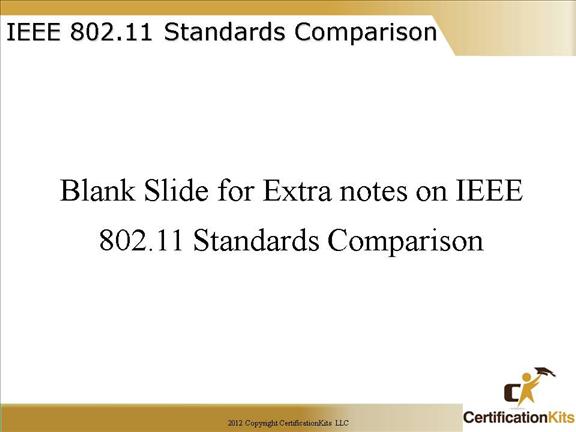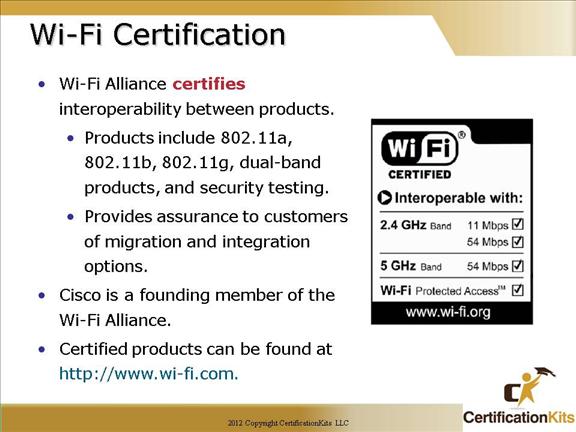Cisco CCNA Introduction to Wireless LANs
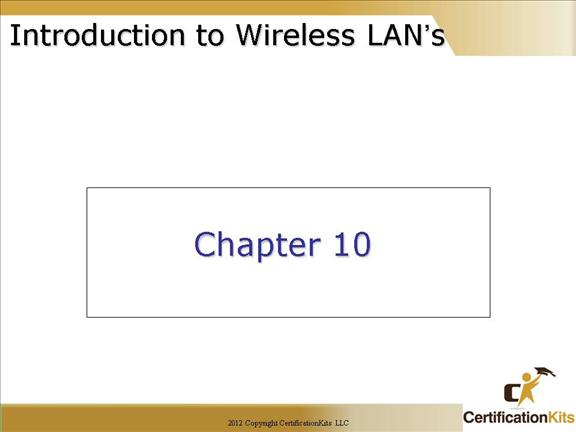
This chapter will cover Wireless LAN’s.
Cisco CCNA Differences Between WLAN and LAN
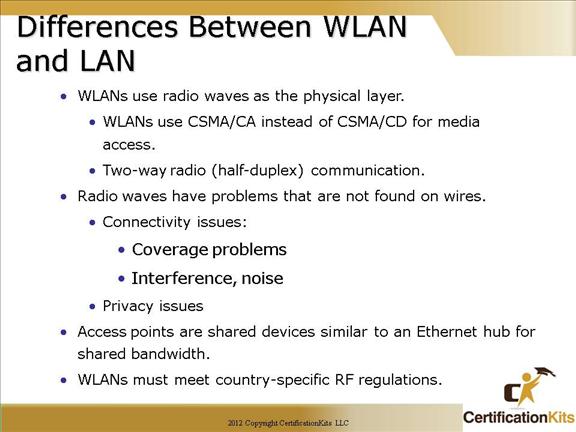
Following is an explanation of how WLANs differ from LANs.
-> In WLANs, radio frequencies are used as the physical layer of the network.
– WLANs use CSMA/CA (Carrier Sense Multiple Access with Collision Avoidance) instead of CSMA/CD (Carrier Sense Multiple Access with Collision Detection) that is used by Ethernet LANs. Collision detection is not possible because a sending station cannot receive at the same time that it is transmitting and, therefore, cannot detect a collision. Instead, the Request to Send (RTS) and Clear to Send (CTS) protocols are used to avoid collisions.
– WLANs use a different frame format than wired Ethernet LANs. Additional information for WLAN is required in the Layer 2 header of the frame.
-> Radio waves have problems not found in wires.
– Connectivity issues in WLANs can be caused by coverage problems, RF transmission, multipath distortion, and interference from other wireless services or other WLANs.
– Privacy issues are possible because radio frequencies can reach outside the facility.
-> In WLANs, mobile clients connect to the network through an access point which is the equivalent for a wired ethernet hub.
– Mobile clients do not have a physical connection to the network.
– Mobile devices are often battery powered as opposed to being electrically powered as they are for LANs.
-> WLANs must meet country-specific RF regulations.
– The aim of standardization is to make WLANs available worldwide. Because WLANs use radio frequencies, they must follow country-specific regulations of RF power and frequencies. This requirement does not apply to wired LANs.
Cisco CCNA Radio Frequency Transmission
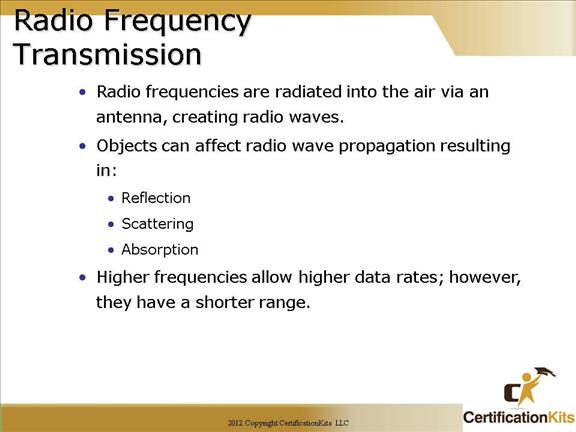
Radio frequencies are radiated into the air by antennas that create radio waves. When radio waves are propagated through objects, they may be absorbed by some objects (for instance, walls) and reflected by other objects (for instance, metal surfaces). This absorption and reflection may cause areas of low signal strength or low signal quality.
The transmission of radio waves is influenced by the following factors:
Reflection: Occurs when radio frequency (RF) waves bounce off objects (for example, metal or glass surfaces).
Scattering: Occurs when RF waves strike an uneven surface (for example, a rough surface) and are reflected in many directions.
Absorption: Occurs when RF waves are absorbed by objects (for example, walls).
The following rules apply for data transmission over radio waves:
- •Higher data rates have a shorter range because the receiver requires a stronger signal with a better signal to noise ratio (SNR) to retrieve the information.
- •Higher transmit power results in greater range. To double the range, the power has to be increased by a factor of 4.
- •Higher data rates require more bandwidth. Increased bandwidth is possible with higher frequencies.
- •Higher frequencies have a shorter transmission range through higher degradation and absorption. This fact can be compensated with more efficient antennas.
Cisco CCNA Organizations That Define WLAN
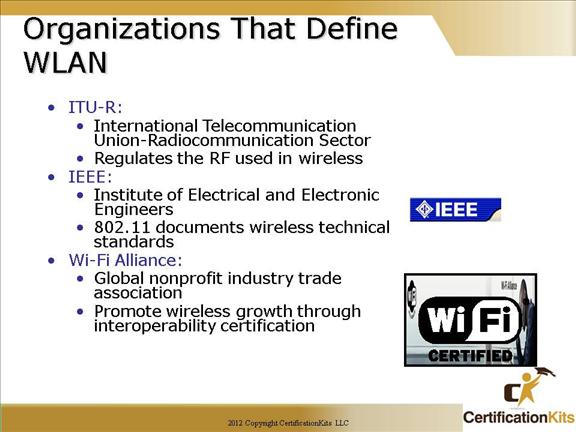
Regulatory agencies control the use of the RF bands. With the opening of the 900-MHz ISM band in 1985, the development of WLANs started. New transmissions, modulations, and frequencies depend on the approval of the regulatory agencies. A worldwide consensus is required. Regulatory agencies include the Federal Communications Commission (FCC) for the United States (http://www.fcc.gov) and the European Telecommunications Standards Institute (ETSI) for Europe (http://www.etsi.org).
The IEEE defines standards. 802.11 is part of the 802 networking standardization. You can download ratified standards from the IEEE website (http://standards.ieee.org/getieee802).
The Wi-Fi Alliance offers certification for interoperability between vendors of 802.11 products. This certification provides a comfort zone for the users who are purchasing the products. It also helps to market the WLAN technology by promoting interoperability between vendors. Certification includes all three 802.11 RF technologies and Wi-Fi Protected Access (WPA), a security model released in 2003 based on the new security standard IEEE 802.11i, which was ratified in 2004. The Wi-Fi promotes and influences WLAN standards. Ratified products can be found on the Wi-Fi website (http://www.wi-fi.org).
Cisco CCNA ITU-R with FCC Wireless
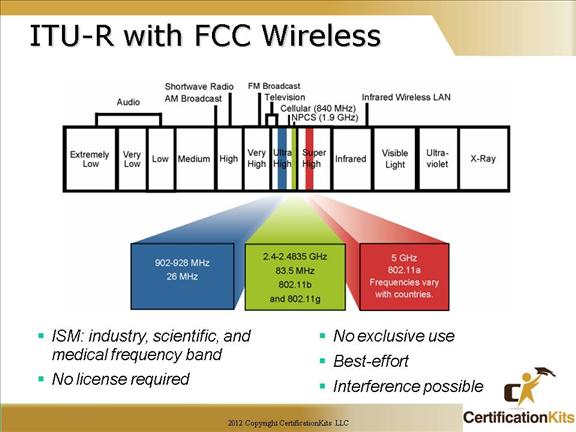
There are three unlicensed bands: 900 MHz, 2.4 GHz, and 5.7 GHz. The 900-MHz and 2.4‑GHz bands are referred to as the Industrial, Scientific, and Medical (ISM) bands, and the 5‑GHz band is commonly referred to as the Unlicensed National Information Infrastructure (UNII) band.
Frequencies for these bands are as follows:
900-MHz band: 902 MHz to 928 MHz.
2.4-GHz band: 2.400 MHz to 2.483 GHz. (In Japan, this band extends to 2.495 GHz.)
5-GHz band: 5.150 MHz to 5.350 MHz, 5.725 MHz to 5.825 MHz, with some countries supporting middle bands between 5.350 MHz and 5.825 MHz. Not all countries permit 802.11a, and the available spectrum varies widely. The list of countries that permit 802.11a is changing.
The figure shows WLAN frequencies. Next to the WLAN frequencies in the spectrum are other wireless services such as cellular phones and NPCS (Narrowband Personal Communication Services). The frequencies used for WLAN are ISM bands.
Unlicensed frequency bands do not require a license to operate wireless equipment. However, there is no exclusive use of a frequency for a user or a service. For example, the 2.4-GHz band is used for WLANs, video transmitters, Bluetooth, microwave ovens, and portable phones. Unlicensed frequency bands offer a best-effort use, and interference and degradations are possible.
Even though three frequency bands do not require a license to operate equipment, they still have certain local country code regulations inside the frequencies to limit characteristics such as transmitter power, antenna gain which increases the effective power, and the total summation of transmitter, cable, and antenna.
Effective Isotropic Radiated Power (EIRP) is the final unit of measurement used by local country regulatory. Therefore caution should be used when attempting to replace a component of wireless equipment such as an antenna to increase range. The possible result could be a total wireless system that is illegal for the local codes.
EIRP = transmitter power + antenna gain – cable loss
Note : Only use antennas and cables supplied by the original manufacture listed for the specific access point implementation. Only used qualified technicians who understand the many different variations and requirement to comply with local RF country regulatory codes.
Cisco CCNA IEEE 802.11 Standards Comparison
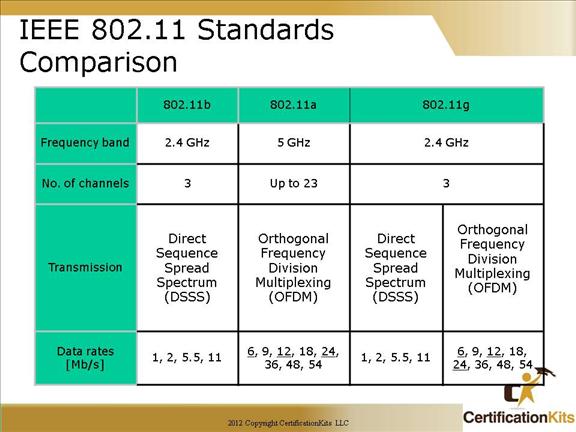
The original 802.11 wireless standard was completed in June 1997, revised in 1999 (802.11a/b) and reaffirmed in 2003 (802.11g). The IEEE standard defines the physical layers and MAC sub-layer of the Data-Link layer of the OSI model. Be design the standard does not address upper layers of the OSI model. Three modulation techniques of Infrared (IR), Frequency Hopping Spread Spectrum (FHSS), and Direct Sequence Spread Spectrum (DSSS) where originally defined. Light based IR medium quickly became obsolete leaving FHSS and DSSS for most implementations.
FHSS transmissions jump frequencies in a defined algorithm to minimize interference while DSSS uses just one channel that spreads the data across all frequencies defined by that channel. Since both technologies use a different approach to minimizing interference, they are mutually incompatible.
The IEEE 802.11 divided the 2.4GHz ISM band into 14 channels, however local regulatory such as FCC designate which channels are allowed such as channels 1 through 11 for FCC in the United States. Each channel of 2.4 GHz ISM band is 22 MHz wide with 5 MHz separation resulting in overlap with channels before or after a defined channel for usage. Therefore a separation of 5 channels is needed to ensure unique non-overlapping channels. Given the FCC example of 11 channels, the maximum of non-overlapping frequencies are channels 1, 6, and 11.
Cisco CCNA IEEE 802.11 Standards Comparison Recall earlier that wireless is a half-duplex communication and therefore the basic throughput is only about half of the data rate. Therefore, IEEE 802.11b main development goal was to achieve higher data rates within the 2.4 GHz ISM band and therefore continue the growing Wi-Fi consumer market and acceptance. 802.11b defined the usage of DSSS with newer encoding or modulation of Complementary Code Keying (CCK) for higher data rates of 5.5, and 11 Mbps over that prior Barker Coding of 1 and 2 Mbps. 802.11b still used the same 2.4 GHz ISM band and was backward compatible with prior 802.11 and it’s associated data rates of 1 and 2 Mbps. During the same year as 802.11b, IEEE developed another amendment known as 802.11a. This standard was motivated by the continued goal of increasing data rate through a different Orthogonal Frequency Division Multiplexing (OFDM) spread spectrum and modulation technology and to use a less crowded frequency of 5 GHz UNII. The 2.4 GHz ISM band was widely used for all thing wireless such as Bluetooth, cordless phones, monitors, video, home gaming consoles, and also happens to be the same frequency used by microwave ovens to heat water and food at high energy. The 802.11a was not as widely known since materials for chip manufacturing was less readily available and initially resulted in higher cost. Most all applications requirements were satisfied by the cheaper and widely available 802.11b. A more recent development by IEEE to maintain usage of the 802.11 MAC and obtain higher data rates in the 2.4 GHz ISM band. This resulting IEEE 802.11g amendment used newer OFDM from 802.11a for higher speeds, yet was backward compatible with 802.11b using DSSS since it was already using the same ISM frequency band. Therefore DSSS data rates of 1, 2, 5.5, and 11 Mbps are supported plus OFDM data rates of 6, 9, 12, 18, 24, 48, and 54 Mbps although IEEE only require mandatory data rate of OFDM using 6, 12, 24 Mbps regardless of 802.11a or 802.11g OFDM. Cisco CCNA Wi-Fi Certification The Wi-Fi Alliance is a global, nonprofit industry trade association devoted to promoting the growth and acceptance of wireless LANs. One of the primary benefits of the Wi-Fi Alliance is to ensure interoperability among 802.11 products offered by various vendors by providing certification. This certification provides a comfort zone for the users purchasing the products because of the certified vendor interoperability. Certification includes all three IEEE 802.11 RF technologies, as well as early adaption of pending IEEE drafts such as security. The Wi-Fi Alliance adapted IEEE 802.11i draft security as Wi-Fi Protected Access (WPA), and then revised to WPA2 after final release of IEEE 802.11i.
